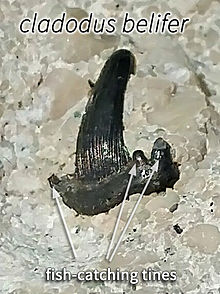Cladodus
| Cladodus Temporal range:
| |
|---|---|

| |
| Cladodus belifer tooth with fish-catching tines | |
| Scientific classification | |
| Kingdom: | Animalia |
| Phylum: | Chordata |
| Class: | Chondrichthyes |
| Order: | †Symmoriiformes |
| Family: | †Cladoselachidae |
| Genus: | †Cladodus Agassiz, 1843 |
| Species | |
|
See text | |
Cladodus is an extinct genus of cartilaginous fishes in the family Cladoselachidae. As the name implies, they are a type of cladodont, primitive sharks with teeth designed to snag fish and swallow them whole, instead of sawing off chunks to swallow.
Fossils of Cladodus have been found in Barkip, Scotland[1] and in the Pitkin Formation (Carboniferous period) in Arkansas, United States. In addition, fossils attributable to Cladodus are known from the Manning Canyon Shale of Carboniferous age in the state of Utah.[2]
Species[]
- †Cladodus alternatus St. John & Worthen, 1875
- †Cladodus angulatus Newberry & Worthen, 1866
- †Cladodus bellifer St. John & Worthen, 1875
- †Cladodus divaricatus Trautschold, 1874
- †Cladodus elegans Newberry & Worthen, 1870 [3] Remains (braincase and a tooth) have been found in Scotland (Clackmannan Group).[4]
- †Cladodus eriensis Bryant, 1935
- †Cladodus formosus Hay, 1902
- †Cladodus gailensis Feichtinger et al., 2021 [5]
- †Cladodus marginatus Agassiz, 1843
- †Cladodus mirabilis Agassiz, 1843 (type species)
- †Cladodus pandatus St. John & Worthen, 1875
- †Cladodus springeri St. John & Worthen, 1875
- †Cladodus vanhornei St. John & Worthen, 1875
- †Cladodus yunnanensis Pan, 1964
See also[]
References[]
- ^ Catalogue of the western Scottish fossils (Public domain ed.). Blackie. 1876. pp. 76–. Retrieved 19 February 2012.
- ^ Mickle, Kathryn E. (9 September 2011). "The early actinopterygian fauna of the Manning Canyon Shale Formation (upper Mississippian, lower Pennsylvanian) of Utah, U.S.A." Journal of Vertebrate Paleontology. 31 (5): 962–980. doi:10.1080/02724634.2011.595622. Retrieved 9 September 2020.
- ^ Comments on the selachian genus Cladodus Agassiz, 1843. Christopher J. Duffin and Michal Ginter,Journal of Vertebrate Paleontology, 2006, Volume 26, Issue 2, pages 253-266, doi:10.1671/0272-4634(2006)26[253:COTSGC]2.0.CO;2
- ^ The Braincase and Jaws of Cladodus from the Lower Carboniferous of Scotland. Michal Ginter and John G. Maisey, Palaeontology, March 2007, Volume 50, Issue 2, pages 305–322, doi:10.1111/j.1475-4983.2006.00633.x
- ^ Feichtinger, I.; Ivanov, A. O.; Winkler, V.; Dojen, C.; Kindlimann, R.; Kriwet, J.; Pfaff, C.; Schraut, G.; Stumpf, S. (2021). "Scarce ctenacanthiform sharks from the Mississippian of Austria with an analysis of Carboniferous elasmobranch diversity in response to climatic and environmental changes". Journal of Vertebrate Paleontology. 41 (2): e1925902. doi:10.1080/02724634.2021.1925902. S2CID 237518044.
Categories:
- Prehistoric cartilaginous fish genera
- Mississippian fish of North America
- Elasmobranchii
- Taxa named by Louis Agassiz
- Fossil taxa described in 1843
- Carboniferous fish of Europe
- Fossils of Austria
- Prehistoric cartilaginous fish stubs